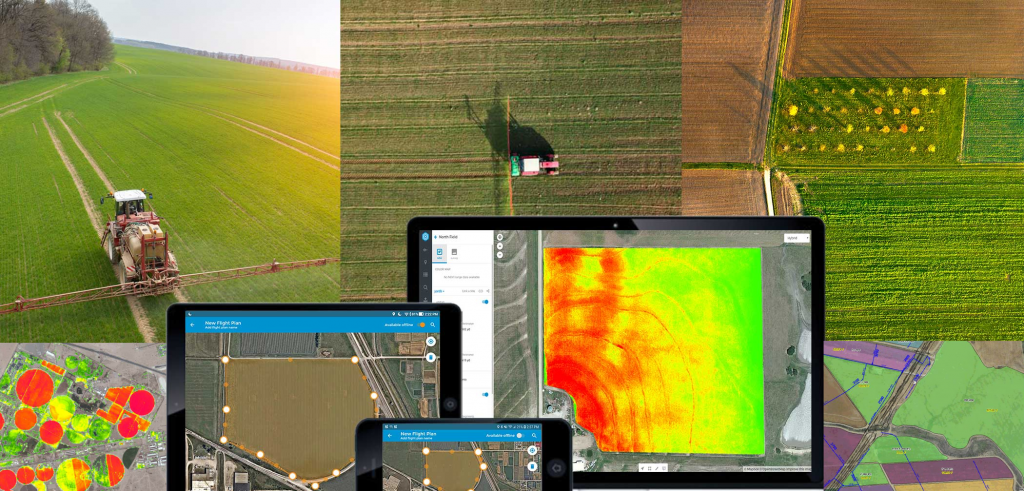
Executive Summary
Introduction and Scope
This is the final compiled report of crop yield prediction for kharif 2019, covers European Space Agency images analysis based results of acreage estimation of guwar, paddy, cotton, crop health monitoring and NDVI based yield.
Star Agribazaar Technology Limited started developing crop area estimation procedures and crop yield models, based on the application of satellite remote sensing, GIS technology, agronomy, agro-meteorology, statistics and other allied disciplines.
Conventionally, crop yield prediction and area estimation with satellite-based crop assessment has been developed to forecast and estimate crops statistics of major crops which includes Guwar, Paddy and Cotton.
Excerpts of the Report
In comparison to last year’s (2018) total productivity, the total crop production has experienced a slight increase whereas area sown this year is comparatively lesser than previous year.
2018: Total crop production – 3,64,666 tons
Total area sown – 6,53,697 ha
2019: Total crop production– 3,96,838 tons
Total area sown – 6,13,944 ha
Amongst this, total paddy production has experienced 1,14,493 tons of total production. Total cotton has been predicted to be 91,770 tons including poor, moderate and good quality while guwar production has been predicted to be 1,90,674 tons including all the three types while .
- Paddy:
The total acreage for paddy of poor quality in kharif season 2019 has been forecasted at 4,295 ha being the lowest among all other qualities of the same. Similarly, the total paddy acreage for moderate quality in kharif season 2019 has been estimated at 15,072 ha, experiencing medium acreage this kharif season. For paddy of good quality, the acreage is predicted to be 16,322 ha having the maximum area sown for the season.
- Cotton:
The total area sown for poor quality in kharif season 2019 has been indicated at 19,353 ha being the lowest among the other types of cotton sown. The acreage total for moderate quality cotton has been predicted at 45,502 ha noticing medium acreage this season. Finally, the paddy of good quality has been evaluated with the maximum acreage at 77,907 ha.
- Guwar:
The total guwar acreage for poor quality in kharif season 2019 has been estimated at 1,45,502 ha. Simultaneously, the total guwar acreage for good quality in kharif season 2019 has been estimated at 1,11,237 ha, experiencing the minimum area sown for the same crop. The good quality guwar has experienced medium acreage this season in Ganganagar district. Guwar acreage for moderate quality in kharif season 2019 has been predicted at 1,78,753 ha having the maximum acreage estimation.
Introduction
Hanumangarh is a city in the Indian state of Rajasthan, situated on the banks of the river Ghaggar also identified as Ancient Sarasvati river. The district is mostly dry with no precipitation and the temperature of the city rises during the day to 24 °C-25 °C and dips by the night to 14 °C-15 °C.
- Soil Type: The types of soil available in Rajasthan are mostly sandy loam to loamy sand having good drainage property & calcasious sub soil. The level of organic matter or nitrogen in the soil is low. In the city, the soil has P2O5 being low to medium & K2O levelling medium to high. Groundwater is usually saline.
- Crop Varieties: Since the city is bounded on the north by Punjab state, on the east by Haryana state, on the south by Churu District of Rajasthan, and on the west by Ganganagar District of Rajasthan, the major work of the district is farming including rice, millet, cotton, sonamukhi (senna), wheat, and vegetables. Here, we are focusing mainly on the assessment of major crops in the area, i.e. cotton, paddy, and guwar.
- Agricultural Economy: The agricultural sector in Rajasthan counts for 22.5% in the GSDP (Gross State Domestic Product), out of which Hanumangarh contributes around 886.8 ha of agricultural land in the state entirely.
In India, Rajasthan alone produces 70%-75% guwar among other crops and grows country’s 60%-62% guwar grains. The total productivity of guwar in Rajasthan is 370 kg/ha with an area of 28 LA. Out of this, Hanumangarh produces 20% of total guwar grains in an area of 247.4 ha with productivity of 604 kg/ha.
As for cotton, whole of Rajasthan produces 3,37,307 tons of cotton with a yield of 692 kg/ha every year. Out of this, sole productivity in Hanumangarh is 4.16 kg/ha on an average every year.
Similarly, total paddy production in Rajasthan is 2.047 lakh tonnes in India. Hanumangarh solely grows 0.79 lakh tonnes on an average every year.
Objective
The main objective of the project envisages satellite based crop yield prediction, acreage estimation, and health monitoring of Guwar, Cotton and Paddy crops for Kharif 2019-20 in Hanumangarh, Rajasthan using Remote sensing and GIS techniques, Agronomy, agro-metrology Statistical Data and Machine Learning algorithm.
Study Area
This is a study for kharif 2019 in Hanumangarh district of Rajasthan, India stretched between 29° 37′ 33.5856” N latitude and 74° 17′ 14.9676” E longitude covering an area of 9,656 km². The total study area covers 7 talukas including Bhadra, Hanumangarh, Nohar, Pilibanga, Rawatsar, Sangaria and Tibi. The map below shows the talukas covered in Hanumangarh.
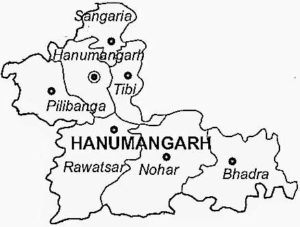
Scope of the Project
To conduct this study, under mentioned applications were covered.
- Crop yield prediction and acreage estimation of all guwar, cotton and paddy differentiated in selected varieties i.e. poor, moderate, and good.
- Satellite image based crop health monitoring and analysis – using Sentinel 1 and Landsat satellite data
- Satellite derived NDVI based yield estimation.
- Total guwar, cotton and paddy acreage estimation and crop yield prediction in all 7 talukas of Hanumangarh district.
Data set Used
- Multi – Spectral and multi-temporal satellite (Sentinel-2) data has been widely used in the field of agriculture for estimation of area under different major crops like Gwar, Cotton and Paddy etc.
- Weather and average rainfall data used for crop model.
Rainfall and Climatic Conditions
Most of the agriculture in India is rainfall dependent. Current year has shown changes in rainfall pattern all over India. This year the monsoon has arrived in the country later than expected. Hence continuous monitoring of the weather has been undertaken. The graph below depicts the precipitation estimation this Kharif season 2019 in Hanumangarh district. Rainfall in Hanumangarh has exceeded 100 mm in the season.
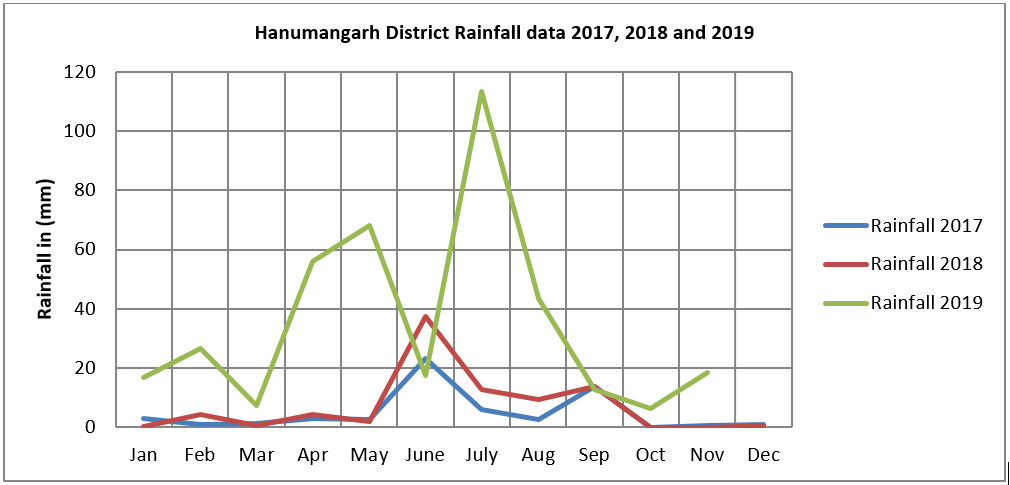
The graphical representation below is the temperature data of Ganganagar predicted for this Kharif season 2019. The maximum temperature in the district being higher than 40 °C is analyzed in 2019. The graph compares the temperature condition for previous 2 years i.e. 2017 and 2018 followed by 2019.

The map below depicts an overall deficiency in rainfall pattern of the country. India Meteorological Department has recorded a deficient precipitation in the state. Rainfall being merely 18.6 cms in Rajasthan, production of cotton has been severely affected with a heavy downfall.
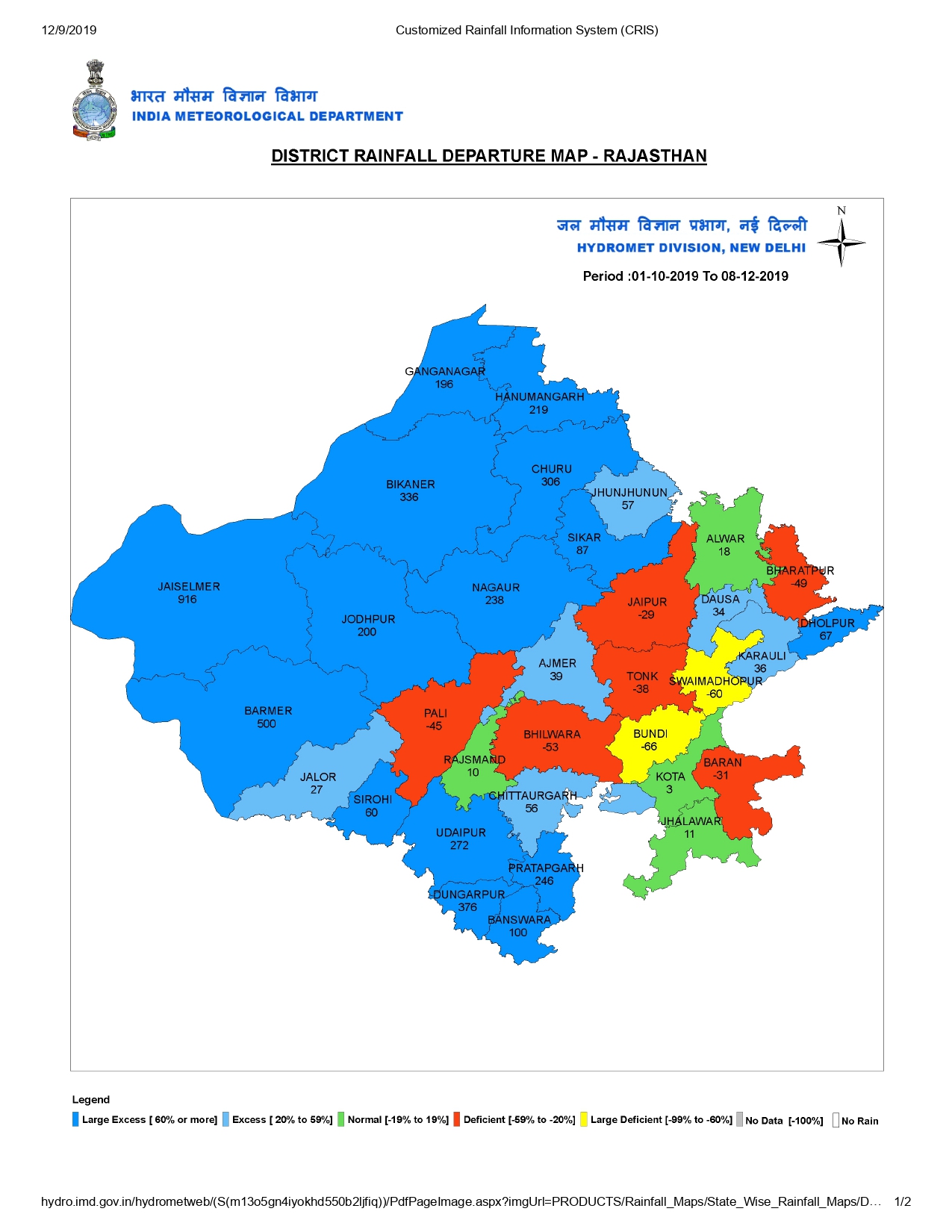
Results
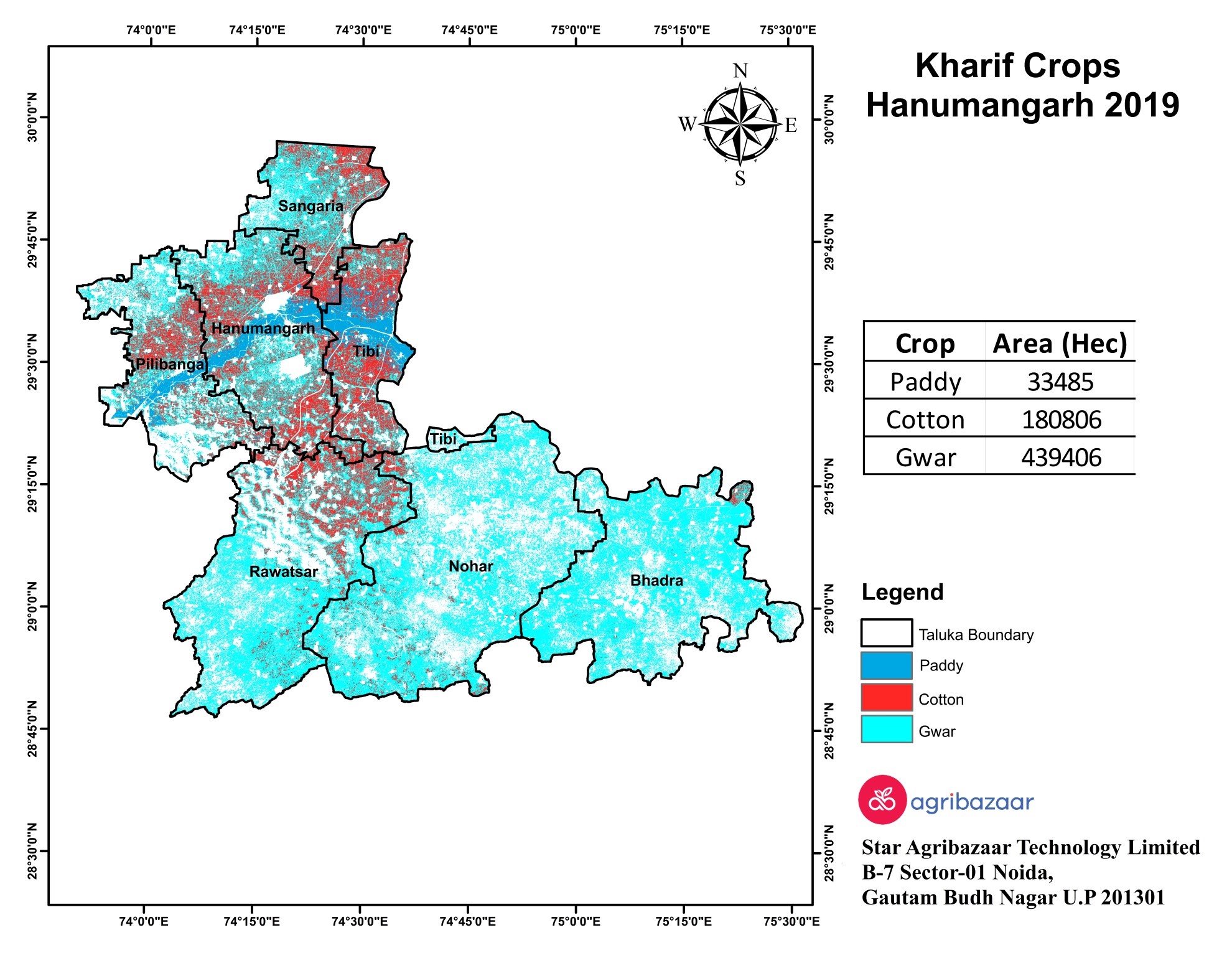
- Crop Production: As per the crop assessment in the Hanumangarh district, Guwar crop experiences the highest production i.e. 190674.18 tons (48%) as compared to the rest of the crops (paddy & cotton) in the Kharif season 2019.
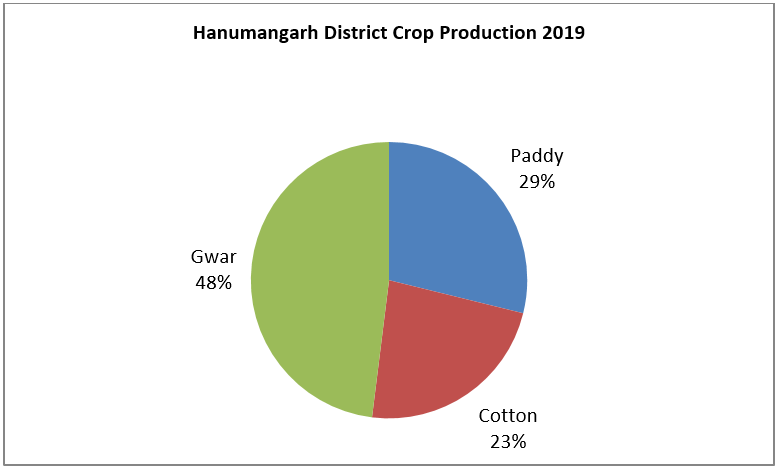
- Crop Variation: The crop acreage in Kharif season 2019 is expecting Moderate Guwar quality to be produced the highest. The crop is estimated to yield in a sown area of 1,78,753 hectares while the good and poor quality is predicted to be sown in 1,11,237 hectares and 1,45,502 hectares of agricultural land, respectively. On the other hand, cotton and paddy are still evaluated to be grown at a relatively lower scale.
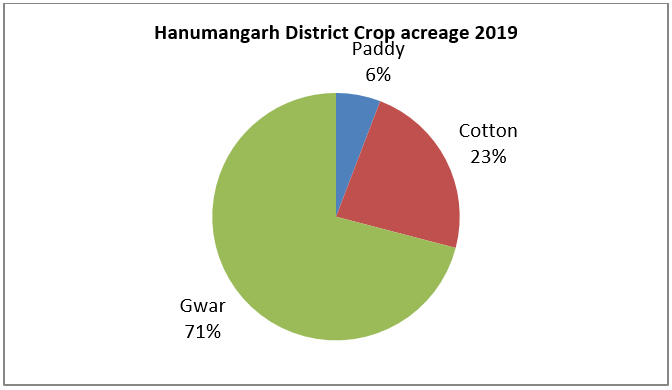
- Yield Estimation (Crop-wise): The image below represents the graphical representation of yields estimated in this season. The predicted assessments evaluate that Guwar crop of moderate quality will be the best yield this Kharif season in Ganganagar.
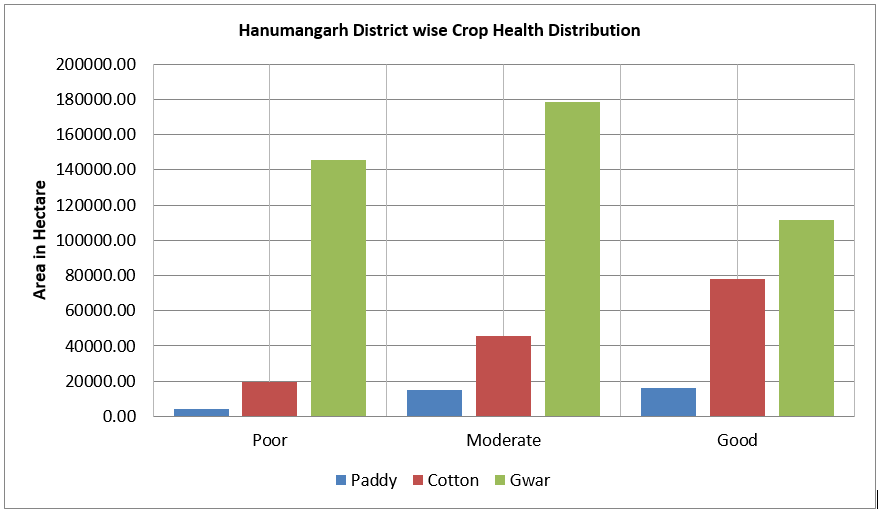
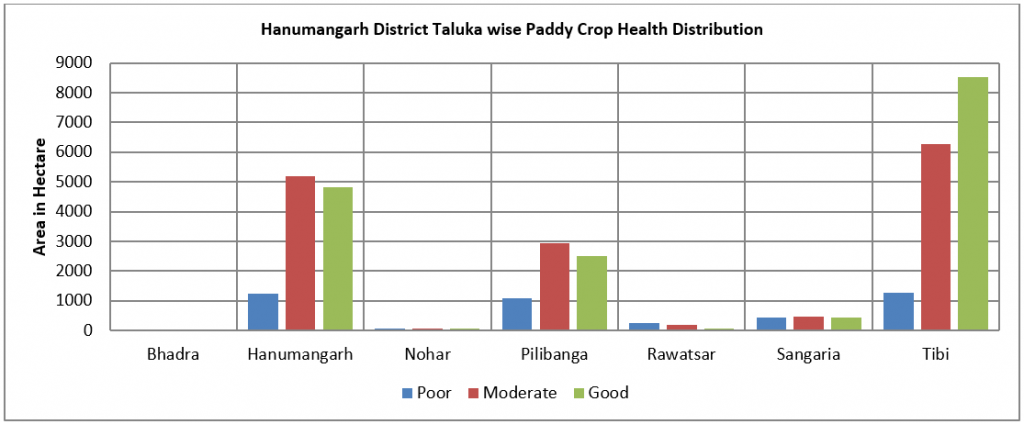
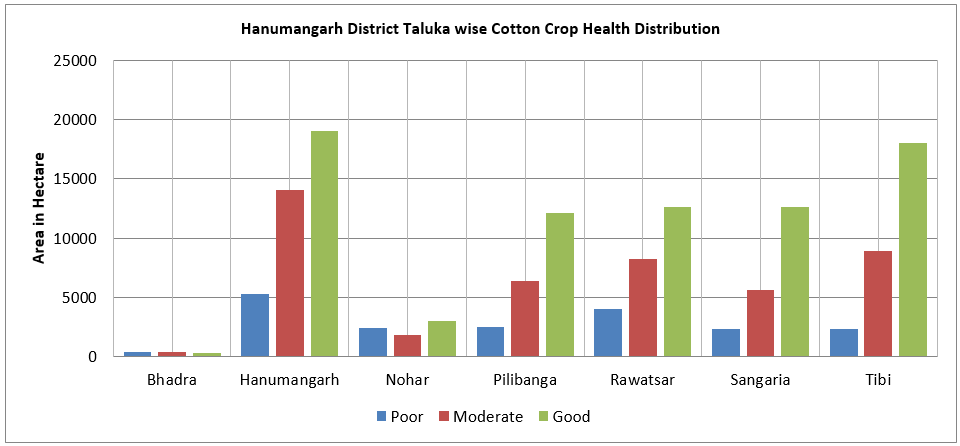
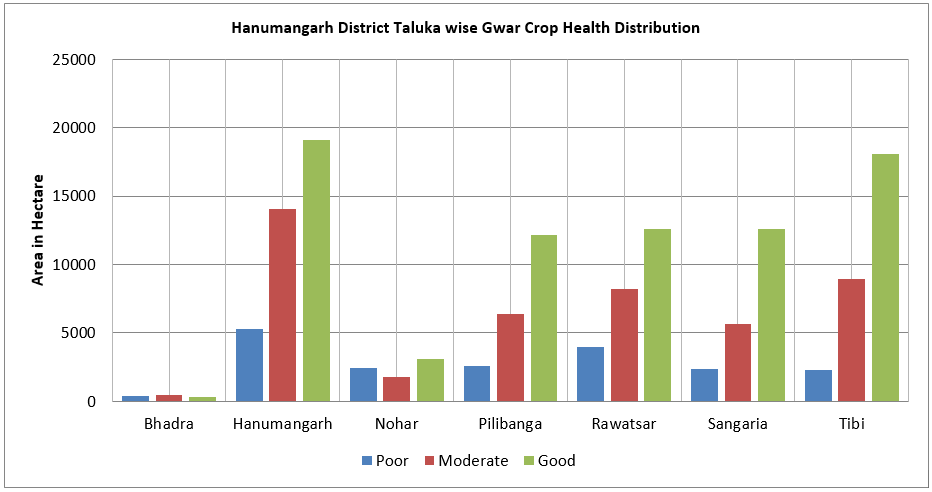

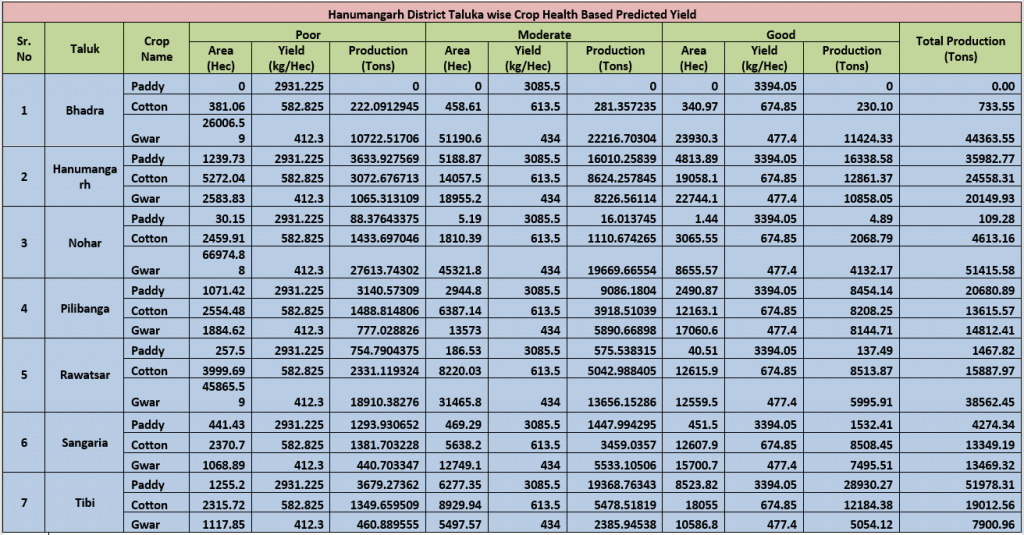
Crop health map of Hanumangarh kharif crop 2019
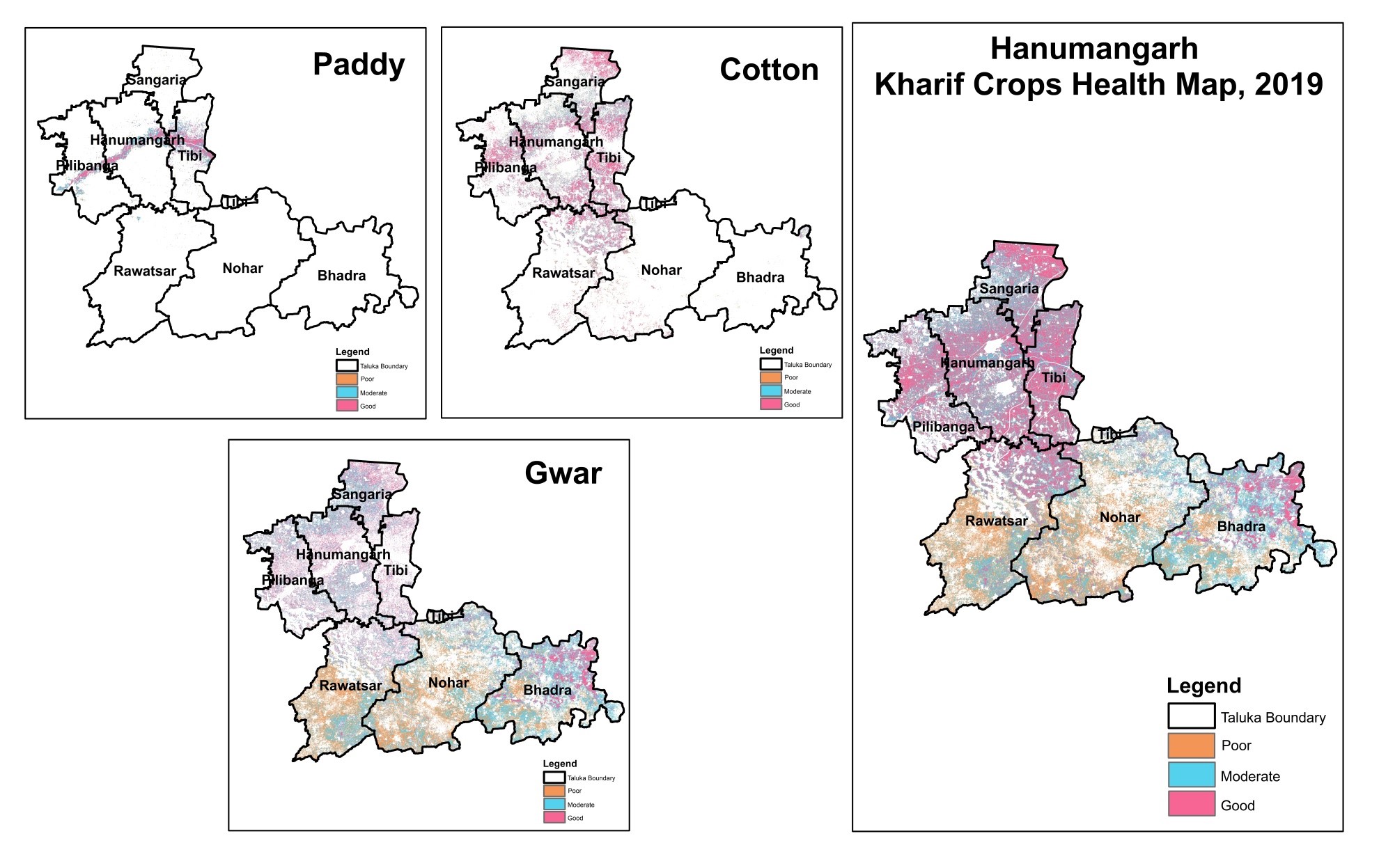
Conclusion
According to the estimated data for Hanumangarh, Paddy crop has experienced an increase in its area sown and the total production this season. While if the data assessed for Guwar and Cotton is analyzed, the difference in the total area sown has experienced a heavy downfall. The comparison in the production for Guwar crop is raised by a difference 42595 tons.
Conclusively, production in paddy has been increased this Kharif season as compared to the yield the previous year. But examining the entire data estimated for this season, Guwar (moderate quality) is the highest produced crop in Hanumangarh.
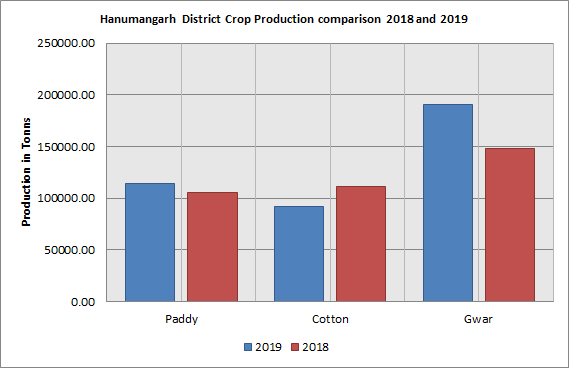
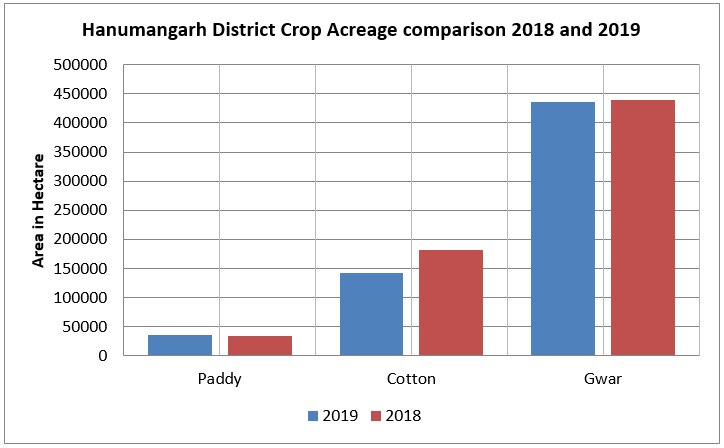
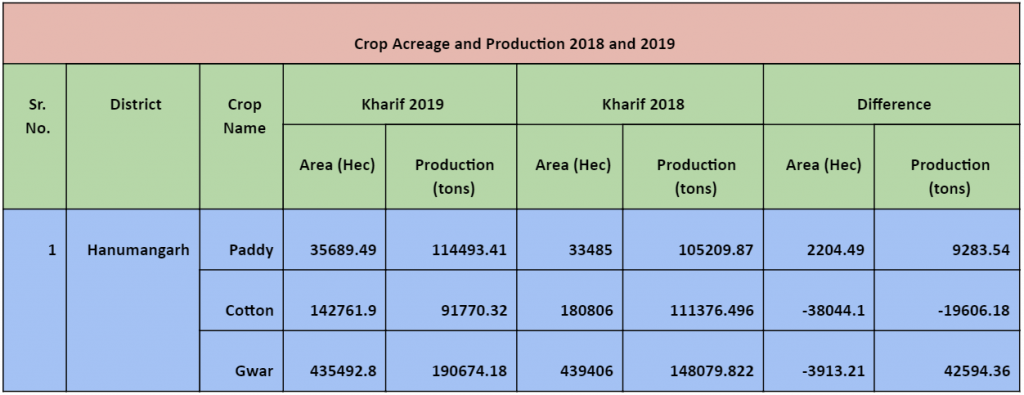

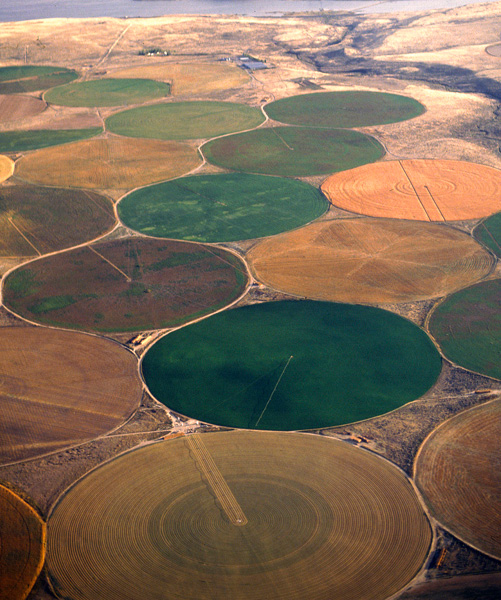
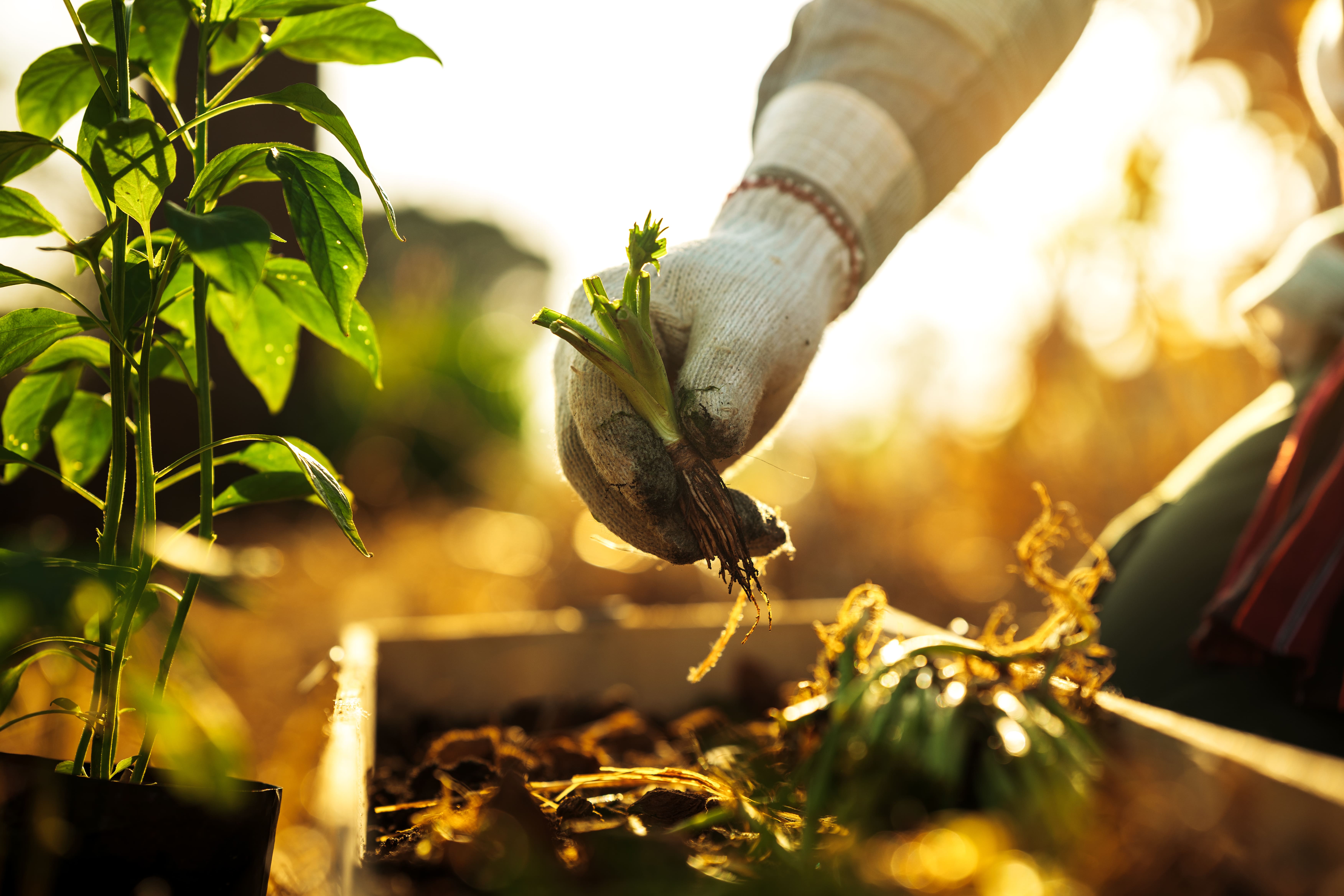
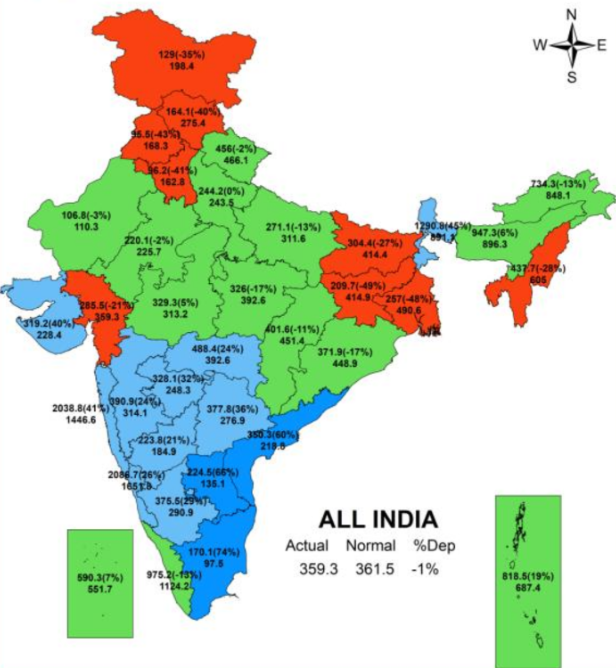
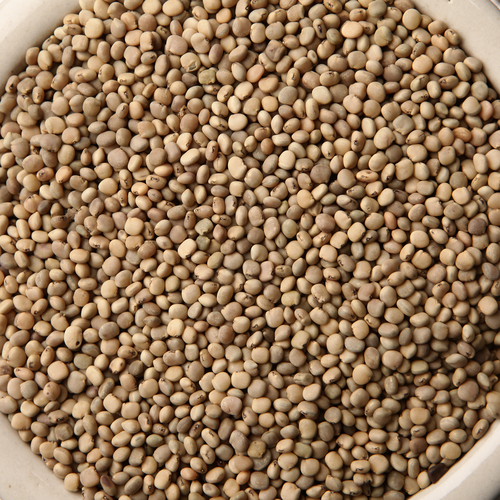
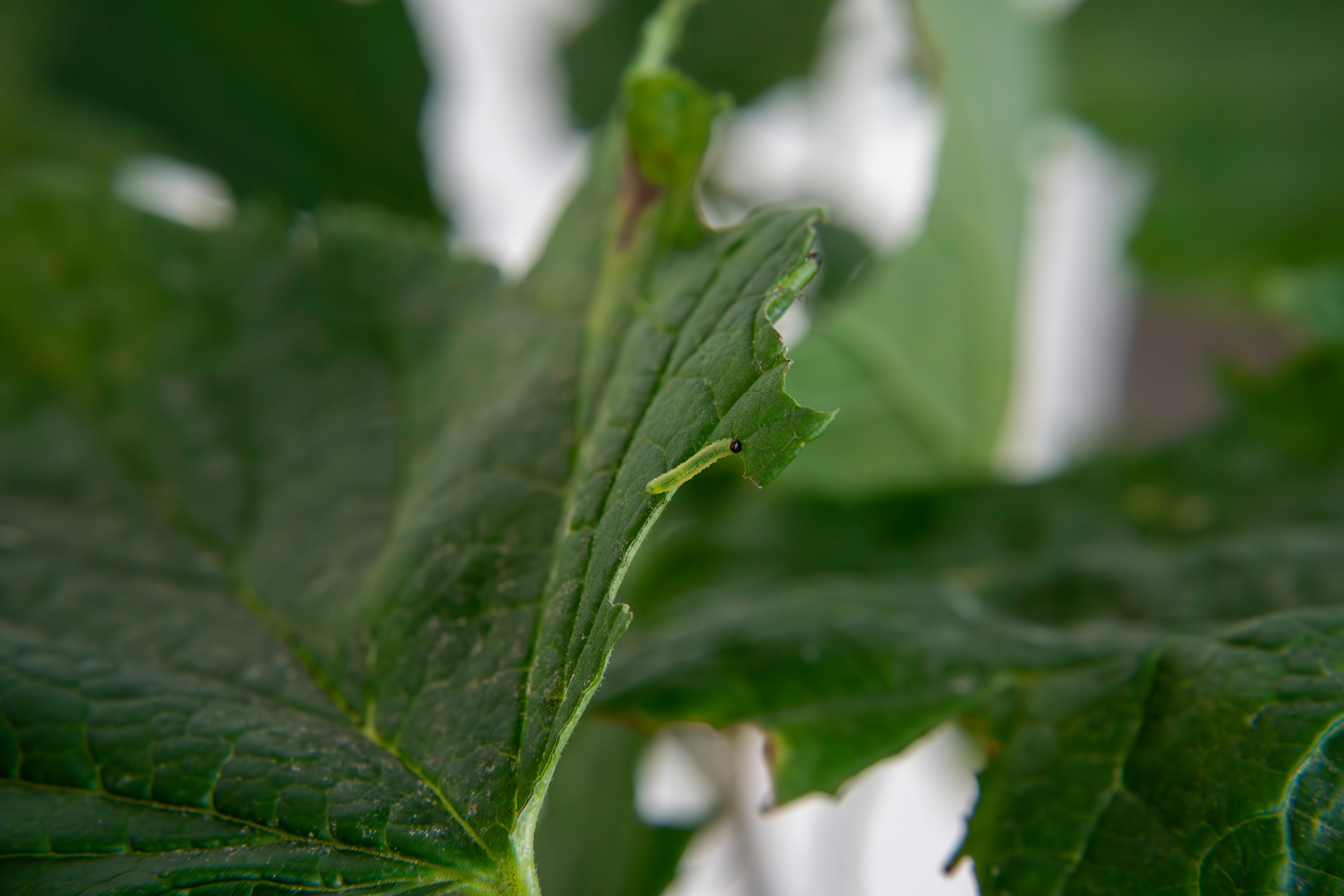

 Connect With Us
Connect With Us